Guide to 2024 Hurricane & Storm Season at Disney World
One downside to summer & fall trips to Walt Disney World is tropical storm season. This post covers the 2024 Atlantic hurricane season forecast, tips for staying dry during rain & preparedness info for staying safe during Florida’s intense weather. (Updated March 3, 2024.)
In recent years, Hurricanes Dorian, Matthew, Irma, and Ian have all impacted the parks and resorts to varying degrees–in some cases, causing multi-day closures. This is definitely something to be cognizant of before booking your trip. This isn’t to say you should avoid September or other peak hurricane months, but it’s important to be aware of while weighing the pros and cons of various times to visit.
In an average year, the NOAA forecasts over a dozen named storms. While this is a lot of storms, it’s highly unlikely that any of these will make landfall and subsequently significantly impact Walt Disney World. It’s still uncommon to face park closures due to storms, but it has happened several times. However, even storms hundreds of miles off the coast can make for long, rainy days–rather than the normal afternoon showers that are a fact of life in Florida during the summer and fall.
In other words, if you’re visiting Walt Disney World during the storm season months of June through November 2024, it’s good to be prepared. If you’re visiting between August and October 2024–the heart of hurricane season–it’s also key to have a plan for more major storms.
With that in mind, let’s start with a look at the upcoming Atlantic hurricane season forecast and how it could have an impact on Walt Disney World…
2024 ATLANTIC HURRICANE SEASON FORECAST
Meteorologists are starting to release their forecasts for Atlantic hurricane season in 2024. Typically, the Colorado State University Tropical Weather and Climate Research Team, National Oceanic and Atmospheric Administration and National Hurricane Center all release fairly reliable and non-sensationalized forecasts. We’ll update this section when those forecasts are released.
In the meantime, we have the forecast from two outlets that have varying degrees of credibility. The first is AccuWeather, which in its forecast sounded alarm bells that a “super-charged” hurricane season is possible in 2024. This could be a “blockbuster” hurricane season, AccuWeather hurricane experts warn, as all of the ingredients are coming together for explosive tropical development in the Atlantic this year.
While the Atlantic hurricane season does not officially start until June 1, there are already “serious and growing concerns” about the impending season, AccuWeather Chief Meteorologist Jonathan Porter said. There are two key factors that have AccuWeather forecasters sounding the early warning of a potentially super-charged season: The return of La Niña and historically warm water across the Atlantic Ocean.
It could be a back-loaded season in 2024, as La Niña might not officially develop until late summer or early autumn. The timing of the onset of La Niña could also dictate whether this upcoming season will be similar to the 2020 season, or if the number of tropical systems will fall short of historic levels. AccuWeather’s forecast alone would not be serious cause from concern, as there is a degree to which their reporting is sensationalized. However, it’s corroborated by another outlet.
That’s the WESH 2 forecast by local meteorologist Eric Burris. Last year, that team accurately predicted where every named storm went, and when they made landfall. We’ve found that WESH 2 doesn’t sensationalize storm season, and instead presents a facts-first approach. Their past forecasts have often been conservative relative to the consensus. (In general, local reporting by the Orlando and other Florida news stations is really good–better than the national coverage.)
Burris and WESH are predicting 16-20 named storms, 8-10 hurricanes, and 3-5 major hurricanes. WESH also identified potential hotspots for activity, all of which pointed to the eastern Gulf coast. This is particularly concerning for Florida, with Burris adding that not only is Florida under a higher threat for tropical impact, but “perhaps the greatest threat I’ve forecast since beginning these long range outlooks years ago.”
WESH attributes this in large part to the transition from El Niño to La Niña and sea surface temperatures, but goes deeper than that. They also cite Lezak’s Recurring Cycle, a meteorological technique that uses the past to predict the future, to identify long-term weather patterns repeating themselves in cycles. (If you click this WESH link, it goes into detail about specific dates that have the potential for a return of past weather patterns. It’s a fascinating read!)
Again, we’ll update this section once the NHC, NOAA, and various reputable universities release their 2024 hurricane season forecasts. What follows is the rest of our general advice on visiting Walt Disney World during storm season–and our experience staying at Walt Disney World while the parks closed due to a hurricane…
Our Hurricane Experience
There is ample reason for trepidation if you’re thinking of visiting Walt Disney World in the summer or fall. As Hurricane Dorian, Matthew, and Irma demonstrated, these Atlantic storms have the potential to dramatically alter a vacation. The past is the best predictor of the future, so seeing how Disney dealt with Hurricanes Irma & Matthew could be helpful if you’re concerned about a hurricane impacting your Walt Disney World vacation during storm season.
Hurricane Irma caused Walt Disney World to be closed for two full days and resulted in some damage around the resort. As noted above, we got stuck in Walt Disney World after our Disney Cruise Line Bahamas sailing was canceled (and we were unable to rebook our flight due to the mass exodus of people trying to leave Florida).
You can read about that in Our Hurricane Irma Experience at Walt Disney World, which is like a trip report…but with none of the normal fun stuff, like attractions. It covers what we did to prepare for the storm, how Walt Disney World’s “ride out” Cast Members handled operations, and much more.
What you need to know for rainy days versus during hurricanes and tropical storms is radically different. With the exception of certain attractions and entertainment that might shut down for regular storms, it’s business as usual for Walt Disney World during the rain. That’s not the case during hurricanes and tropical storms, when operations can be brought to a screeching halt. Luckily, that’s very uncommon.
Although the prospect of visiting during rain or hurricane season might be unsettling, there also is some upside, as you’ll read…so it’s not all bad. Let’s take a look at how to prepare for, and deal with, summer storms at Walt Disney World; from regular small storms to tropical storms to even hurricanes. Let’s start with what you need to know for the worst case scenario…
Hurricane History, Official Policies, Preparedness Tips & Info
Hurricanes have caused Walt Disney World to close on six occasions. In 1999 for Hurricane Floyd; in 2004 on separate occasions in a six-week span for Hurricanes Frances, Charley, and Jeanne; in 2005 for Hurricane Wilma; in 2016 for Hurricane Matthew; in 2017 for Hurricane Irma; and in 2022 for Hurricane Ian.
That’s an average of about one closure per decade…plus three times in the last decade. There are also several other times when the parks have closed early, or the water parks and certain resorts have closed–but all of that is much more common and not something that’s closely tracked as a result. Suffice to say, the odds are against your trip to Walt Disney World being severely impacted by a hurricane. Nevertheless, storms are becoming increasingly common.
I’ve heard of some travel agents strongly encouraging guests to purchase travel insurance if visiting Walt Disney World in late summer or early fall. I can’t say that I agree with that advice, but then again, I’m not risk averse. We only purchase travel insurance when going abroad, and that’s only in case I get in a fight with a monkey and have to be hospitalized. With that said, here’s what you need to know if a hurricane or tropical storm is forecast during your visit.
Walt Disney World has a Hurricane Policy that will allow you to get a refund on any package booked through Disney. Of course, this won’t cover your airfare. Fortunately, recent storms have caused significant changes in severe storm policies among major airlines, so that shouldn’t be an issue, either. If that leaves any gaps in expenses you’ve paid for, any decent credit card will have you covered.
If you normally purchase travel insurance anyway, or you still want travel insurance specifically for hurricane season, make sure you get coverage that actually will do something for you in the event of hurricanes or storms. Most basic policies do not provide coverage for weather, so you’ll want to actually read the policy before you buy. In most cases, you’re going to have to purchase a more expensive policy that allows cancellation for any reason.
Beyond monetary loss, there’s the issue of safety, particularly during hurricanes. In terms of safety, Walt Disney World was built for strict compliance with hurricane readiness standards and has earned “StormReady” status from the NOAA. for this type of thing (regardless of how uncommon they are). In terms of preparedness, Disney is absolutely on the ball.
You literally wouldn’t be able to leave your room without receiving a status update of what’s going on, how operations will be affected, and what to do in case of an emergency. There are also notices up around the resorts and in-room televisions have more information than you’re likely to need on Disney’s channels.
Disney errs on the side of caution with this stuff, and you’d pretty much have to bury your head in the sand to not know what’s going on. You really won’t need anything beyond the information Walt Disney World will provide to you in order to keep safe, but if you want to be especially safe, we recommend reviewing FloridaDisaster.org’s information, including on evacuation routes.
Additionally, we recommend having at least a three-day supply of food, water and medicine on hand. Also, before the storm approaches, ensure cell-phones and other devices are fully charged (including external battery packs) in case of electrical power loss.
Storm Season Packing
When packing for a trip during storm season, you’ll want to make sure you come prepared in terms of rainwear and footwear. In terms of rainwear, you could pay $79.56 (slight exaggeration–only slight) for a poncho in the parks, or you could bring your own. You should instead get a cheap 10-pack of ponchos that are serviceable before your trip (or two 10-packs, depending upon how many people are in your group).
If you want something more robust that will keep you dry and is reusable, get this 5-Pack of “Pro” Ponchos. While these are technically disposable, they’re a thicker and higher quality material than the ponchos above. We’ve found that they’re easy to reuse–just hang them up to dry in your room at the end of the day! Unless you really want to throw away your ponchos after each use, this is definitely the superior option.
Second, footwear. Nothing is worse than walking miles around Walt Disney World in wet shoes. Trust me. Popular options to avoid this problem are traditional Crocs cogs. Personally, I prefer Crocs sandals because they don’t quite scream “80 year old hospital patient” quite as much. If you’re more serious about your footwear, consider hybrid water/athletic shoes; the best options we’ve found here are the Teva Churn (for men) and RYKA Hydro (for women).
Finally, accessorize with a Frogg Toggs Chilly Pad. This isn’t for the rain itself, but the heat and humidity that come once the rain leaves. Trust me on this once. These things do wonders for cooling you down, and readers of this blog are big fans of them, as can be evidenced by the comments to our Unique Disney Parks Packing List post.
Regular Rain Showers
There’s a real-world adage that the only certainties in life are death and taxes. If applied to Walt Disney World, that adage would probably be that the only certainties are a 3 o’clock parade and an afternoon shower. Short afternoon showers are fairly regular in Walt Disney World any time of the year, but during the summer and early fall, they are especially common. Plus, unlike the spring showers that might last for 10 minutes before the sun returns, summer storms can be marathon downpours that don’t relent for a few hours.
The prospect of rain should not keep you out of the parks (let alone from not visiting Walt Disney World during these months), as proper packing will make touring during rainy season a breeze. Plus, the rain will scare plenty of other guests away, so a nice afternoon shower might be just the thing to lower those crowds for you. (Although rain isn’t nearly as effective in Walt Disney World as it is in Disneyland–a light sprinkle there and all of the SoCal locals run for the exits!)
If it’s raining when you get up or the forecast is calling for a lot of rain on a particular day of your trip, we recommend going about your day as you normally would. We know, we know, this flies in the face of the “visit Disney Springs” advice offered by a lot of people, but we disagree with that advice.
To us, going to Disney Springs in the rain instead of a theme park doesn’t make a ton of sense. Besides the huge World of Disney, which is approximately twice the size of Manhattan or something like that, you’re going to spend less time in each shop than you would in a single attraction. This means just as much or more time outdoors in the rain than at a theme park.
If we weren’t going to go to the regular parks, we’d go to the water parks. I mean, why not? You’re going to get wet there anyway, so what’s a little rain? We’ve been to Blizzard Beach when it started raining, and for some reason, the place cleared out! If you don’t want to go to a theme park or a water park, consider your hotel’s pool. If you really, really hate the rain, wander around your resort (have a meal?).
Unless you’re from SoCal and are thus scared of rain, there’s no reason to let the rain completely derail your plans. If it’s raining, lots of other guests won’t be in the parks, so you’ll be able to do more than normal! If you do want to go to the parks, but don’t want to get wet, here are some things to do in the parks while it’s raining to minimize your outdoor exposure.
Magic Kingdom
- Carousel of Progress – Rarely has a line meaning you can ride repeatedly if you’d like.
- Tomorrowland Transit Authority PeopleMover – Lengthy, covered ride that gives you a birds’ eye view of rain status.
- Country Bear Jamboree – Grab a snack or meal at Pecos Bill after, as the attraction dumps you out right there.
- Hall of Presidents – Grab a waffle sandwich or dessert at Sleepy Hollow and take it to the covered seating area after.
- Walt Disney’s Enchanted Tiki Room – Shortest show on this list, but it has a covered pre-show, too.
Epcot
- American Adventure – Another place that can eat an hour when you combine the Voices of Liberty with the show. If it’s still raining after the show ends, go back in to take a look at the art in the lobby gallery.
- The Land Pavilion – In EPCOT, there are several pavilions that are large and indoors. At the front of the park, you have both the Land and Seas pavilions. It’s easy to kill time in the Seas simply by looking at aquatic animals–don’t miss the manatees! Over in the Land, there are three attractions, and you can have a meal at Sunshine Seasons or Garden Grill. If you have a bit of money, the Behind the Seeds at Epcot tour is a GREAT (and relatively inexpensive) way to kill an hour and a half or so, too. Doing all of those things is a good way to kill nearly half a day in one pavilion…which is hopefully enough time for the rain to pass!
- Impressions de France – The same could probably be said for the other World Showcase films, but this is one we can watch again and again; it’s so great that we consider it one of Walt Disney World’s most underrated attractions.
Disney’s Hollywood Studios
- MuppetVision 3D – Awesome pre-show and awesome post-show; consider dining at PizzeRizzo or Mama Melrose after the show to avoid rain.
- Star Wars: Rise of the Resistance – A long line, most of which is indoors, makes this a good option during storms.
- Walt Disney Presents – Possibly the best option in all of Walt Disney World if you’re a serious Disney fan and it’s raining; you could easily spend a few hours in here combing over the displays and watching the film.
Disney’s Animal Kingdom
- Finding Nemo: The Big Blue…and Beyond! – The wait for this musical is outdoors, so show up no more than 10 minutes before a show is scheduled to start; you should have no trouble getting in when it’s raining.
- Festival of the Lion King – A long, indoor show; covered character meet & greets are nearby to kill time, too.
- Avatar Flight of Passage – Not so much a long attraction…but an attraction with a really long, indoor queue. That’ll work!
- ??? – If you can avoid going to Animal Kingdom when it’s raining or a lot of rain is in the forecast, that might be best. It’s definitely most enjoyable in nice weather.
Even after our experience with hurricanes and tropical storms at Walt Disney World, we’d have no hesitation to book trips to Florida in the months of August through October, during the height of potential hurricane or tropical storm season. A good attitude to have when the weather gets bad (or when anything goes wrong, for that matter), is that a rainy day at Walt Disney World is better than a normal day at home. Roll with the punches, improvise, and have a good time. Just think, at the very least…rain makes the parks less crowded.
For where to eat, try out our Walt Disney World Restaurant Reviews page. If you want to save money on tickets or determine which type you should get, read our Tips for Saving Money on Walt Disney World Tickets post. Our What to Pack for Disney Trips post takes a unique look at unconventional things you should take on your trip. Once you arrive at the parks, our Walt Disney World “Ride Guides”are great for determining what to do and when to do it. For overviews of all of these topics and so much more, the best place to start is our comprehensive Walt Disney World Trip Planning Guide to make the most of your experience!
Your Thoughts
Do you agree with our mentality about visiting Walt Disney World when it’s raining? Which activities or attractions do you recommend when it’s raining? How do you feel about the controversial subject of travel insurance? Do you have any questions we can help you answer? Hearing your feedback–even when you disagree with us–is both interesting to us and helpful to other readers, so please share your thoughts below in the comments!
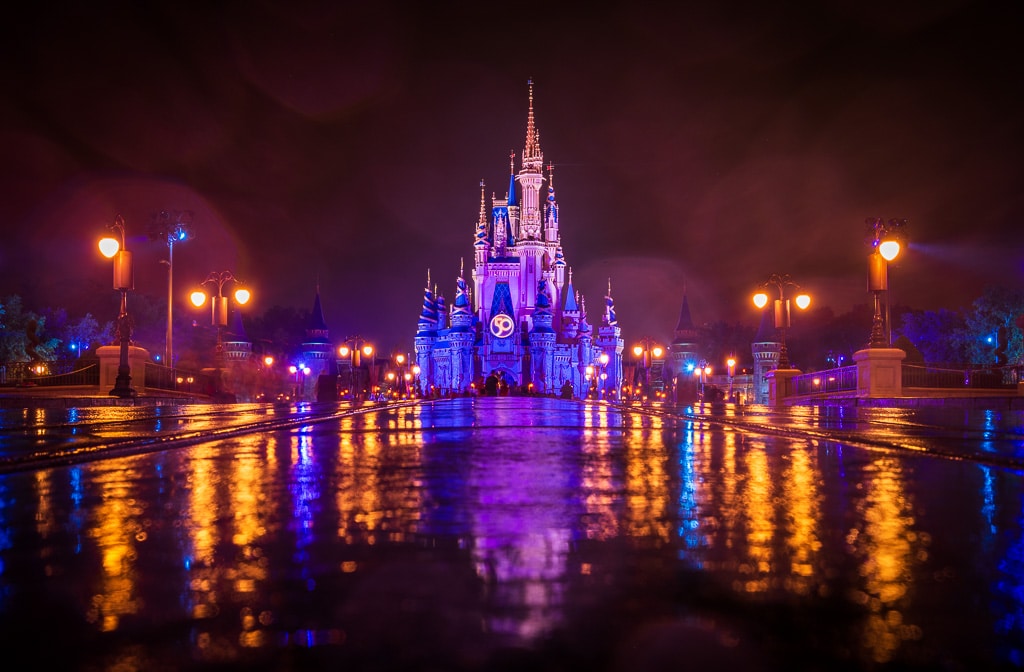
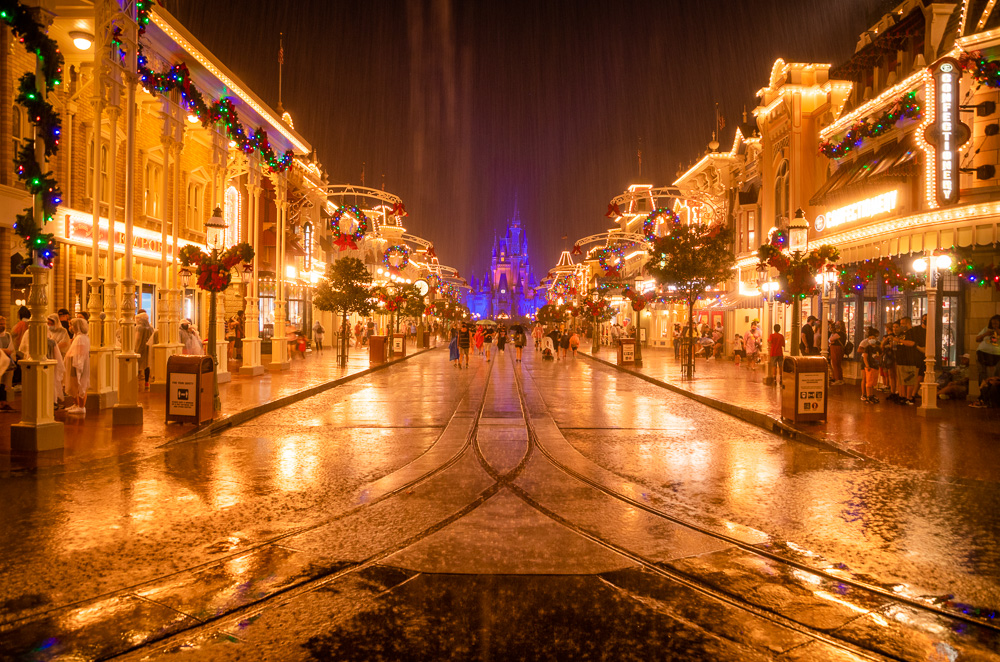
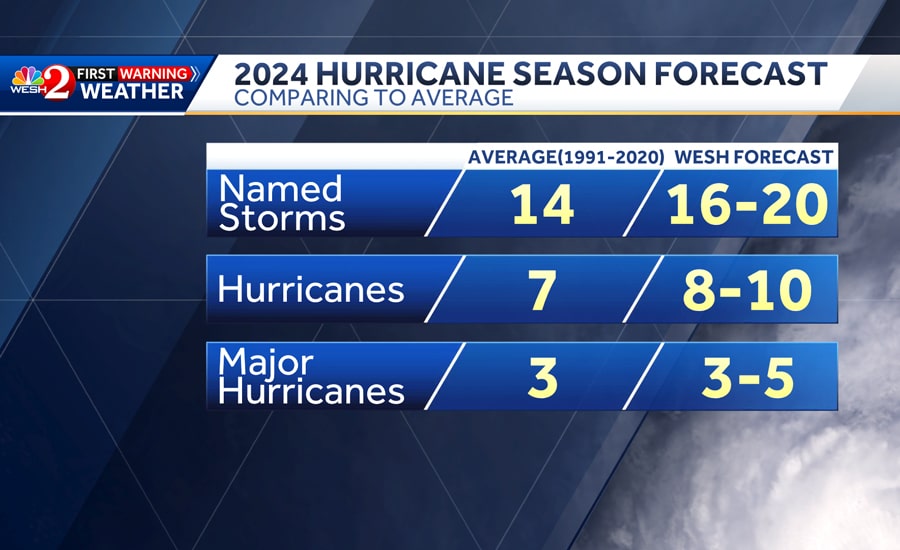
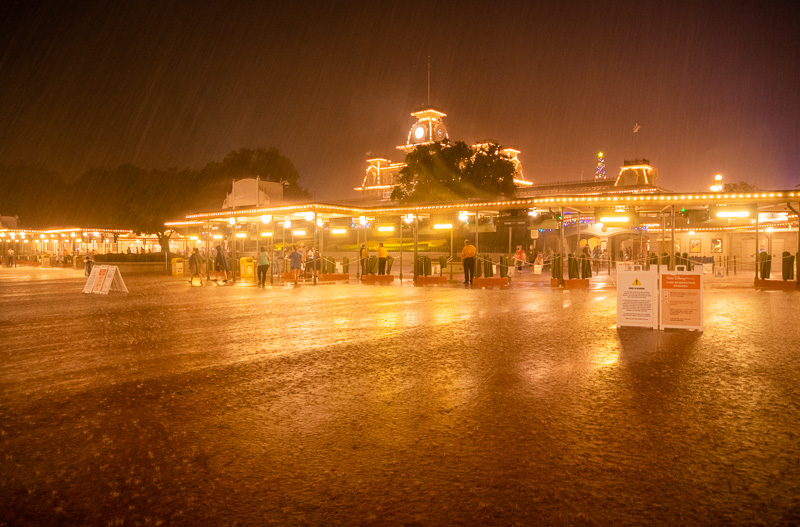
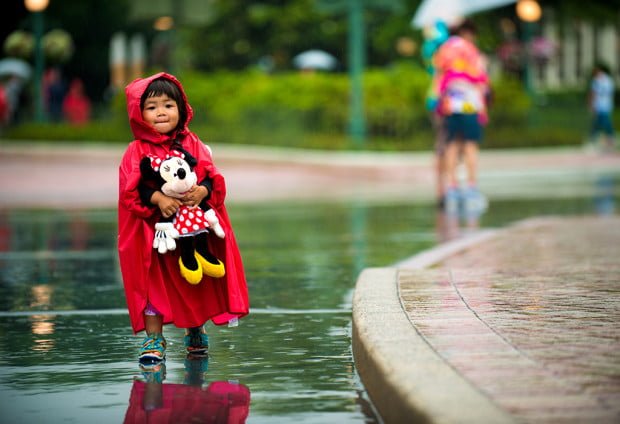
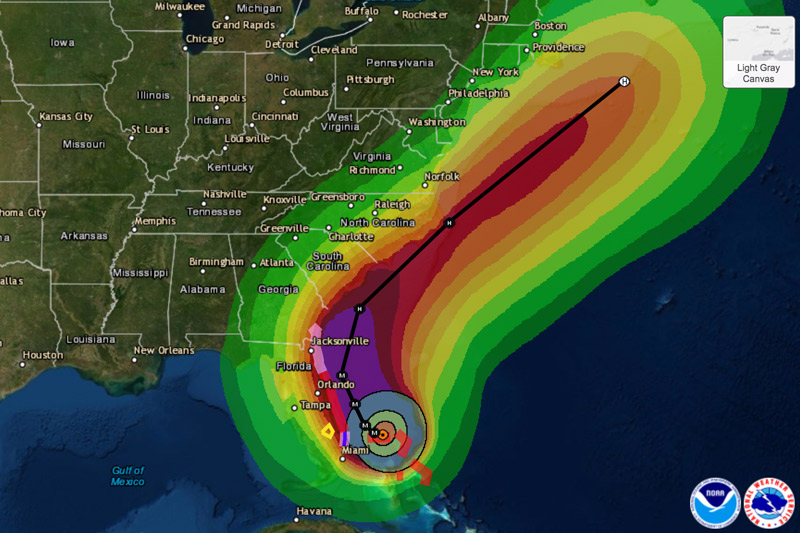
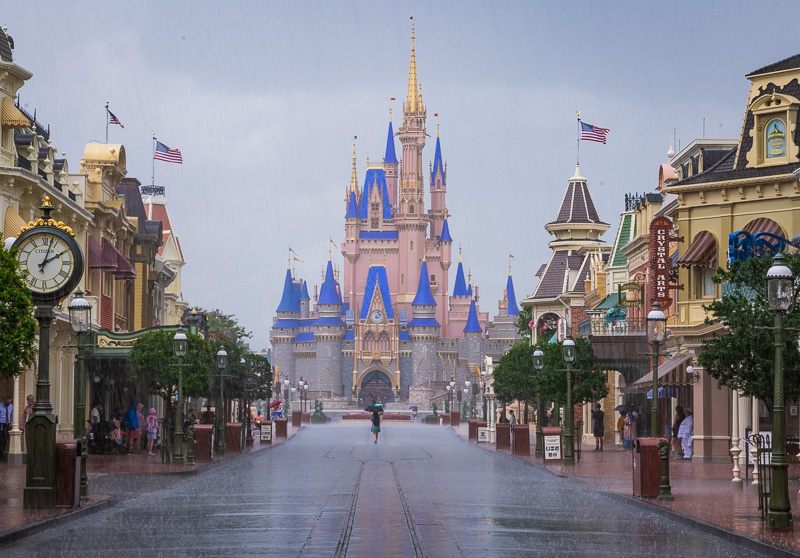
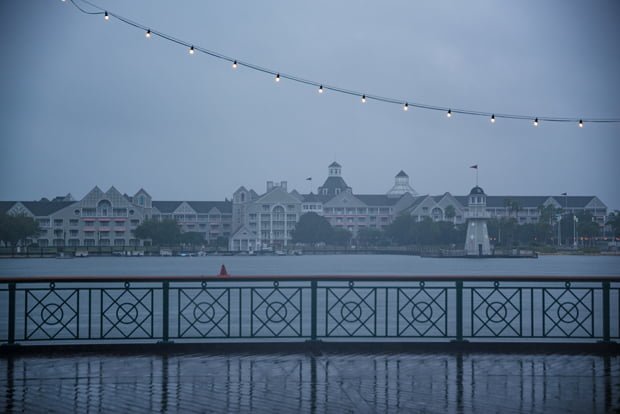
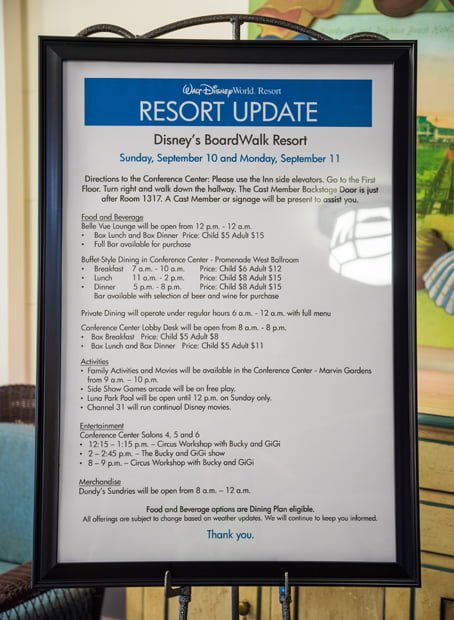
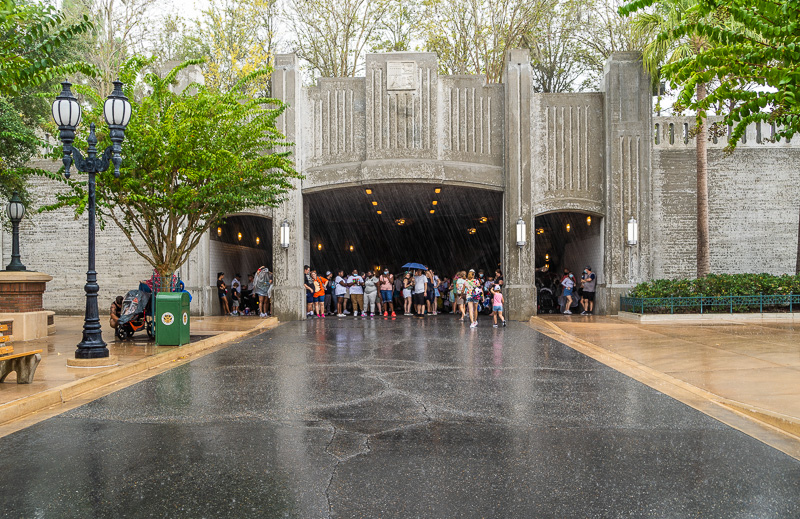
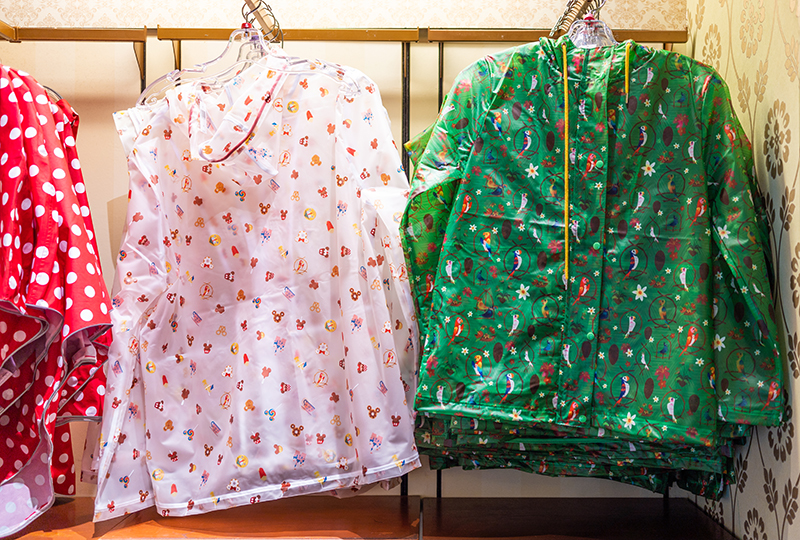
Good information as always. A few years back we arrived a day early to beat a tropical storm that was scheduled, and did, make landfall in the panhandle right when we were scheduled to pass through, so we got a 1 day stay at The Beach Club. We had to wait for the T-storms following the storm to clear out, after which dynamite, and crowbars were needed to get the wife out of Stormalong Bay.
Solid advice. As a waaay too much of a hurricane veteran (there’s a reason there’s a brand-new roof on my house, curse you, Hurricane Ida!), I have some additional advice:
If you have driven in or have a rental car, make sure to top it off before the storm arrives, and I mean make sure it is FULL! Gas pumps will not work if the power fails, and a power failure could last for days or even weeks in worst case scenarios. You can use that full tank of gas to evacuate or as a place of air-conditioning which can power and recharge any devices and the car radio for information.
Cell service, internet and wifi can all be casualties of storm damage, and be offline for hours, days or even weeks. Realistically, WDW is far enough inland that days are the likely worst-case scenario. You also might be lucky enough to go through a bad storm and not lose cell service.
The Skyliner might be down before the storm. IIRC, the cars can be taken off the line and stored in the main station by the Caribbean Beach Resort. It will take time for them to be taken off and stored and time to be put back on.
Wind speed matters. Pay attention to the wind forecasts including the projected wind field. There’s a big difference in the impact of 100 mph winds, 125 mph winds and 140 mph winds. Keep in mind the highest winds will likely be limited in scope, but a minor wobble of 10 miles can mean a world of difference.
Storm Speed matters. Not windspeed, but how fast it is moving. WDW is well inland, hopefully giving time for windspeeds to die down. But if Ian moves fast, windspeeds could remain higher than expected. If it is a slow-moving storm this means more rain, likely with lower windspeeds, but longer exposure to that wind.
Storm track matters. The worst part of a hurricane, the area with the most intense winds is the northeast quadrant of the storm, the upper right quadrant. For WDW, the worst case would be for Ian to pass just to the north, or right over. Best case is for the storm to track south, the further south the better,
If the eye passes overhead, be careful! Inside the eye of a storm is an amazing thing (Hurricane Zeta for me), but the winds WILL return, and you don’t want to out and exposed when that happens, because it goes from 0 to max sustained winds in seconds.
Remember not all resorts are equal. This is true on and off property, not merely for cost, but layout. as you might find yourself trapped in your room (All-Star, Pop Century, CBR, Little Mermaid rooms, Ft. Wilderness cabins) or building (Polynesian, Grand Floridian) due to the resort layout. or you might be able to walk safely to the lobby, dining and other activities without exposure (Yacht/Beach Club, Wilderness Lodge, Boardwalk Inn, etc.)
With that in mind pay attention to the instructions you receive but keep medicine, food and water on hand in your room for several days per person.
Go shopping if needed. There are Walmarts and Targets close by which likely have the things you will need, flashlights, batteries, battery packs (which you should already have, but you might want to add to your stock), water, and food. If you flew and are staying, you can get there via ride services. Check delivery services for what they can provide. Full hurricane prep lists are all over the internet starting with local news services.
Beware of bands. The bands of a hurricane can result in severe weather many miles away from the center of the storm. You can also experience different types of rain from just soaking, to severe thunderstorms with the lightning that will close down many attractions, to rain moving sideways with such velocity that it stings.
After the storm, stay away from downed powerlines and be careful of trees, which still might lose limbs or fall if the ground is saturated.
If you’re staying at a rental home, be very careful messing around with any generators (which you might not be supposed to bring anyway). If you do CAREFULLY follow instructions. Dozens of people have died in recent years due to carbon monoxide poisoning and fires from mishandling portable generators.
The number 1 priority is to stay safe. Please do and good luck.
Hi Tom,
I think you might need to update some of the info of the park suggestions at the end there-
Enchanted Tales with Belle- not reopened
Voyage of the Little Mermaid- not reopened
Innoventions- gone
Fastpass+ – gone
Pizza Planet- Pizzarizzo?
Impressions de France- evening only.
Love your blog though- massively helps me for every Disney trip around the world – especially Tokyo:)
Oof, thanks for the heads up. I thought I did a comprehensive update to this earlier in the year, but apparently not!
Tom –
Currently scheduled to get there next Thursday, which seems like exactly the wrong day. Will Disney let us move everything back 48 hours to avoid the storm? Will airlines usually pre-change our flights? Who would we contact at Disney to see about moving the days?
Typically they will. In this particular case, I have not heard of Disney implementing its hurricane/storm policy exceptions yet.
Call and try now, but don’t be surprised if you’re met with resistance. In which case…try again tomorrow.
Looks like you’ll need to update which storm we are currently keeping an eye on. Hermine just formed off the coast of Africa, so the one that might hit Disney will be called Ian.
Your comment that Southern Californians are afraid of rain is too true!! I was born and raised there but moved to Northern California for college and stayed after graduating. Went to Disneyland with family several times over the years and at the first hint of rain they’d bail for home. My husband, kids and I just whipped out a coat or poncho and kept going. We once did all of fantasyland, Matterhorn, and the subs in less than an hour because the park was empty! Had similar experiences in WDW. We don’t get to either park often so when we are there we power through 😀 Thanks as always for the great article!
Thanks for all the great information. This one was really helpful. Just one thing, according to the Red Cross we recommend a 7-day supply of food, meds and water, and most of all do not forget your “fur babies.” I will remember all the indoor attractions for a rainy day activity. FYI if you have any type of mobility devise make sure your poncho is big enough to cover the devise and batteries as well.
Thank you for the great info. Headed there in a couple weeks and seriously considering the rain suits AND the crocs clogs! Also, these photographs of Disney World in the rain are stunning. So very well done.
MNSSHP on Tuesday, Discovery Cove Wednesday and Galactic Starcruiser Thursday. Fantastic hurricane timing. Ugh.
exactly, i was supposed to travel sept 29 to oct 2nd, looking like i have to cancel now, what are the odds honestly..
I also have tickets for MNSSHP for Tuesday. We started planning this trip years ago (pre-Covid) so we’re just going ahead and hoping for the best.
plan is to arrive tuesday night, parks for four days, MNSSHP on friday night. keeping an eye on this and will be so sad if we have to cancel.
Tom let me add a shoe suggestion. I’ve been wearing Vessi’s Everyday Move sneakers for a bit now and can’t say enough about them. Totally water proof and pretty breathable. A little pricey, but usually on sale and the best part is that I actually wear them all the time, just not only in the parks. Comfortable too. I won’t post a link, because I don’t want to come off as shilling for the company, but a Google search will point you in the right direction. And thanks again for all the work you do!
We were there during Dorian in 2019 and it was fabulous! The storm was so wishy washy- my husband wanted to reschedule and I said we were going. So glad we did! The storm slowed way down and so many others rescheduled and the park (and resort) crowds were low! It was great- didn’t even rain on us at all. Our trip ended the day before she finally made landfall so we were back home in coastal NC by then and had time to prepare our house for her moving up so us.
Tom, that’s old hurricane climatology from 1981-2010. New climatology for an “average” season is 14 named storms with 7 of them hurricanes, 3 of which are major hurricanes. That’s the 1991-2020 data. I’ve been forecasting tropical cyclones worldwide since 1980. I’m thinking we may have one more storm than last year, 22. Of those, 9 hurricanes and 5 major hurricanes. Signs point to even a more active year than what you mentioned here. I think that Florida will be at a significantly higher risk over normal for a hurricane hit this season. The whole East U.S. Coast will be at an elevated risk.
Has Disney traditionally offered good bounce back offers to guests impacted by storm-related park closures?
Tons of useful information, but your article left me wondering, so I have to ask. Just how many monkeys do you usually get into fights with when traveling abroad? Also, who starts the fights? Not enough bananas to go around?
I’ve never gotten into an actual fight with a monkey, but there have been a number of close calls. If you stare wild male monkeys in the eyes, they view you as an aggressor and will attack to assert dominance. Unfortunately, a camera lens often evokes the same response, so I’ve had a few monkeys lunge at me. Most of those incidents have happened here: https://www.travelcaffeine.com/kyoto-monkey-park-review/
We’ve also had confrontations with wild monkeys (and boars) in some other areas of Kyoto. Pretty much all of the mountain temples have monkey problems, and signs up warning tourists not to look them in the eyes. The signs are humorous; the warnings are real.
I am a bit hesitant to travel to Orlando again in hurricane season because of my latest experience. I was there during Hurricane Matthew (October 2016) when Disney World actually shut down for a few days. I was on a road trip from Toronto to Orlando, and was in Charleston at the time they announced we needed to evacuate. We evacuated to Atlanta and had a lot of trouble finding a hotel/bnb because nearly everything was booked. We also had to cram all our universal/Disney park days into 1 week with no breaks because we lost 2 or 3 days due to the hurricane. We ended up skipping 1 day at universal. Not a big deal.
It worked out and we had a ton of fun but it was also quite stressful! Especially not knowing if/when Disney would open back up! Sounds like hurricanes are just becoming more frequent so I’m not sure it’s worth the risk!
Hi Tom, your articles have been so helpful for navigating my next Disney trip! I just have one suggestion: please date your articles! I am often having to scroll to the comments section to find out whether the article is current. 🙂
I finally get a stormed named after me and it’s just a Disorganized Tropical Depression.
Planning trip to Epcot Center only, second week August, was worried bout the storm , hurricanes, I’m from the west coast, so really don’t know how to plan, and suggestions?.
We were there for Matthew in ‘16. We lost one day, but Disney was very accommodating refunding our cancelled Mickey’s Halloween party (though we hated to miss it). We also extended our departure day with little hassle. The biggest piece of advice if a storm is likely to close the parks is get food days in advance. We drive from GA so we were able to run out to the grocery store 2 days early and grabbed bars, chips, bread, PB, drinks, etc for the expected day lockdown in our room. So grad we did, as the afternoon that the parks closed, the dinner lines at the resorts (we were at CBR) were worse than any ride in the park. Cast members did their best, but some guests were very ugly. The key is to plan ahead.
Yeah, watching this one very closely. We are supposed to fly into MCO on Wednesday July 7, in the later evening. Hoping Elsa has decided run away by that point. Or stays out to the west the whole time. Another reason why I hate going in the summer. 2022 its defitiely going back to January. Keep us posted on this storm. Hopefully it doesn’t delay our trip
We have a trip end of September with the understanding that a hurricane or heavy tropical rain could put a damper on it (pun intended). I was at PO Riverside (heavy sigh) the day Hurricane Charley made land and the one thing I learned was to pack food (snacks, not lasagna) in my suitcase, as everything closed as soon as we got to the hotel.
A water resistant jacket is not effective in torrential downfalls, nor is an umbrella or poncho. The only thing that works is waterproof outerwear, including shoes, as Tom described. Having said that, the Disney poncho I purchased decades and decades ago will get packed. I also have disposable ponchos, which do not really keep you dry as they are paper thin. If it’s windy you’re getting wet. The thing I hate about ponchos is not so much the cost but the drying and dripping in the room and the refolding. So I have been online this week looking for a waterproof jacket.
I also thought many people would leave during heavy rain but they did not and the parks remained crowded. One day we were stuck in a torrential downpour in HS and didn’t want to leave because we had dinner reservations at The Brown Derby. When we entered the restaurant, I almost froze to death from the AC. We were immediately seated and after a few minutes the server brought over two white tablecloths that he had heated up (I guess in the microwave) and put them over my shoulders. It felt so good and I was so grateful. And that’s Disney for you.